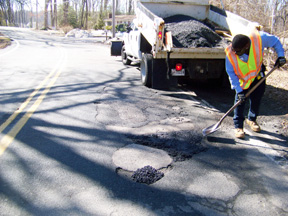Chesapeake Bay's Independent Newspaper ~ Since 1993
1629 Forest Drive, Annapolis, MD 21403 ~ 410-626-9888
Volume xviii, Issue 10 ~ March 11 - March 17, 2010
Home \\ Correspondence \\ from the Editor \\ Submit a Letter \\ Classifieds \\ Contact Us
Best of the Bay \\ Dining Guide \\ Home & Garden Guide \\ Archives \\ Distribution \\ Advertising![]()


A Menace Lurks in the Snow’s WakeIf your car sways on turns, bounces on rough roads or veers at stops, you may have suffered a run-in with a pothole |
|
|
Sixteen-hour snow days haven’t given Anne Arundel County Equipment Operator No. 1 Bernard Woehlke and Maintenance Worker No. 2 Zachary O’Neil time to unhitch the plow from their white Ford F450 county work truck before they’re on to a new assignment.
On this March day, Woehlke and O’Neil have potholes to repair. Work orders in hand, they’re following citizens’ calls on the county’s Pothole Hotline — 410-222-7045 during business hours — to make short work of three North County nuisances.
Potholes find a perfect habitat in Maryland, where our fickle weather contributes to the freezing-and-thawing cycle they thrive on. Potholes form when cracks develop underneath the surface of a roadway or on the side of a road. The cracks widen under the constant pressure of traffic. When it rains, water accumulates in the cracks, and in cold weather that water freezes and expands, pushing upward and outward. When temperatures warm up, the ice thaws and contracts. A gap forms underneath the road surface. Cars travel over the weakened spot until it collapses, and a pothole is born.
These highway pockmarks are more than irritations; they are a public safety hazard. They can damage a car’s shock absorbers or struts, which affect steering and assure a smooth ride. A car’s suspension system can suffer. Potholes can put tires out of alignment, which will cause uneven wear. They can blow out tires, dent wheel rims and pop off hubcaps. Hitting a pothole can also cause a driver to veer into another lane or lose control.
Potholes are so prevalent in winter that in January, Anne Arundel County Executive John R. Leopold promised citizens that pothole complaints would be acted on within two business days. That was before the two blizzards of Snowmageddon dumped nearly four feet of snow on the county’s 6,000 miles of roadway in a week — nurturing the formation of many more potholes.
Few potholes got repaired in February. After the digging out came the drying out. Now, potholes are the order of business.
On the Road with the Pothole Crew
When Woehlke’s shift starts at 7am, he’s already been on the road an hour and a half, traveling in from Goldsboro down the Eastern Shore. This is a chilly morning, but Woehlke and O’Neil don’t wear jackets. Like most who work outside in all kinds of weather, they dress in layers. Woehlke’s top layer is a plaid shirt. Under a baseball cap, he ties his long grey hair in a ponytail. His long grey beard is also tied, in front.
|
|
![]() Woehlke has been with Anne Arundel Public Works for 28 years and O’Neil for four. Their assignments change with the season, from snowplowing to pothole repair to tree and leaf removal to clearing drainage ditches of leaves.
Woehlke has been with Anne Arundel Public Works for 28 years and O’Neil for four. Their assignments change with the season, from snowplowing to pothole repair to tree and leaf removal to clearing drainage ditches of leaves.
The first stop is on Stinchcomb Road in the Severna Park community of Manhattan Beach. This pothole isn’t big enough to swallow your car whole, but it could take a bite out of your tire. Damaged tires mean thriving March business, says nearby Severna Park Goodyear service manager Ron Mauer.
O’Neil climbs out of the truck to brush water out of the hole with a wide, hard-bristle broom. Then both men shovel filler into the hole.
Road crews give potholes a temporary fix in the winter; permanent fixes wait until warmer weather.
For the temporary mix, crews use a cold mix called CR6 — crushed run 6 — that consists of various aggregates including gravel, crushed rock or stone and sand that compact well. Fourteen hundred tons are stockpiled for pothole repair. In spring or summer, crews will go back over the patch to do a hot-mix repair. The hot-mix combines aggregates with hot liquid asphalt cement for a longer-lasting repair. Fifty-five hundred tons of hot-mix are stockpiled.
When the hole is filled, Woehlke climbs back into the truck to run it back and forth over the cold mix, tamping it down. Next O’Neil scatters a little dirt over the mix so that it won’t stick to the tires of cars passing over it.
On the second stop, Woehlke parks the truck in the middle of Manhattan Beach Road and directs traffic with a fluorescent orange flag while O’Neil fills the hole. This one is out in the middle of everything. As cars approach, some drivers slow down, but others speed at the flagman until the last minute. Woehlke says traffic on College Parkway is especially dangerous because of reckless drivers who seem to make it a game to see how close they can come to the repairmen. Others are distracted with cellphones and text messages.
A two-man crew is enough for today’s repairs, but sometimes a job may require more. That’s the case when a large section of highway must be fixed. Then the crew will clear out seven to eight inches of crumbled asphalt, put in four inches of CR6 as a base, then use two inches of base blacktop topped with another two inches of surface blacktop smoothed over by a roller.
Our last job is in Glen Oban, where Woehlke and O’Neil repair a big hole. Then Woehlke points out a large section of road filled with rough rocks. He says it was dug up by a utility crew but that Public Works crews will have to repave it.
You may have encountered a pothole if your car sways on turns, bounces on rough roads or veers to one side at sudden stops. Leaks, rust and dents are visible signs, and the car’s front or rear may sit lower than it should. It’s time for an inspection if you are having any of these problems with your car.
Drive defensively to avoid potholes or minimize their impact on your car. Keep tires at proper air pressure to provide a cushion between a pothole and the wheel rim. Maintain a safe distance when following another car. Slow down when you see a pothole ahead, and do not brake over a pothole. Hold the steering wheel firmly to maintain control.
When you spot a problem pothole on Anne Arundel County roads, call the Pothole Hotline at 410-222-7045. Or e-mail complaints to [email protected]. You may give your name or remain anonymous. The county is not responsible for repairs on state roads. Numbered roads, including Routes 2, 50 and 648, belong to the State Highway Administration, so potholes on those roads are theirs.
© COPYRIGHT 2010 by New Bay Enterprises, Inc. All rights reserved.



